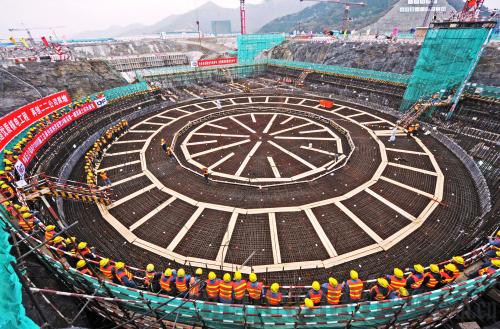|
 |
|
JOINT PROJECT: Construction of the first phase of the Sanmen Nuclear Power Plant started on December 15, 2009 in Zhejiang Province. This is the largest joint power generation project between China and the United States so far (TAN JIN) |
"Clean energy race" has become a catchphrase for journalists and bloggers to attract reader eyes. Googling that, one will be amazed by the number of recent headlines churned out.
American politicians and businessmen reportedly used the race analogy to persuade Congress to pass climate and energy bills that encourage the development of clean energy.
A decade ago, the race was between the United States, Japan and Europe in terms of solar photovoltaic (PV) shipments and Denmark in terms of wind turbine manufacturing. Recently, the race is often framed as being against China.
A report titled "Who is winning the green energy race?" published by the Pew Charity Trusts found, for the first time, China took the top spot for overall clean energy finance and investment in 2009, pushing the United States into second place.
In terms of installed capacity, the report said "the United States led the world in installed wind, biomass and geothermal power capacity, but was very close to losing its top position in overall installed capacity as China surged forward."
On the supply side, Denmark's Vestas and U.S. supplier GE Energy, a subsidiary of General Electric, nearly tied atop the list of the world's two wind turbine producers, while three Chinese companies, Sinovel, Goldwind and Dongfang, entered the global top 10 in 2009, said a report by BTM Consult ApS, a famous Denmark-based consulting firm.
As for solar PV producers, American company First Solar led solar PV module shipment in 2009, followed by Chinese company Suntech Power Holding Co. Ltd. and Japanese company Sharp Electronic Corp., according to IMS Research.
Government policy incentives make the difference, the Pew report points out, those nations with strong national policies aimed at reducing global warming and incentivizing the use of renewable energy are establishing strong competitive positions in the clean energy economy.
The Pew report shows confidence in America's potential to "recoup leadership and a market share" in the future, given the country's entrepreneurial traditions, strengths in innovation and its leadership in venture capital investing.
Behind the smoke and mirrors
In clean energy sectors, policymakers seem to face a dilemma. They pledge to address climate change and accelerate renewable energy technologies, but they are also tempted to nurture and protect domestic clean technology markets to create green jobs at home and ensure domestic political support, said a World Resources Institute (WRI) working paper dated May 2010.
Some TV political campaign advertisements during the U.S. midterm election suggested that money for renewable energy projects had been sending "jobs to China," the American Wind Energy Association (AWEA) found.
To debunk false political advertisements, AWEA released a statement on October 14. It cited data from the U.S. International Trade Commission, which said China currently represents less than 5 percent of the imported value of turbine components for the U.S. market.
So far, only three of 33,000 (0.009 percent) wind turbines installed across the United States were sourced from China, stated the AWEA.
The market share of Chinese turbine manufacturers on a worldwide basis grew significantly in 2009, yet "to date, that growth has been based almost entirely on sales to the Chinese market," according to the U.S. Department of Energy in its 2009 Wind Technologies Market Report.
None zero-sum game
Framing the global clean energy industry in competitive terms is not adequate in some senses. The race metaphor, some experts say, fails to take into account the clean energy industry's increasing global integration.
The WRI report found the solar PV value chain has experienced fast globalization over the past years, through cross-border investment flows, and especially through high levels of cross-border trade in raw materials and intermediate and finished products.
Local job creation is at the heart of calls for a more protectionist configuration of national trade and investment regimes, the WRI report noted.
"Because of the way supply chains are interconnected, you can't win the clean energy race by banning technologies from other countries or by banning investment because it hurts U.S. companies," Barbara Finamore, China Program Director at the Natural Resources Defense Council told The Washington Independent, a non-partisan online news network.
"I actually think healthy, peaceful international competition in this sector is one of the best ways to promote the development of these technologies and their deployment around the world," Teryn Norris told Miller McCune magazine.
Norris is an energy policy analyst and former project director at the Breakthrough Institute, a California-based think tank striving to let us "enjoy secure, free, prosperous, and fulfilling lives on an ecologically vibrant planet."
Another problem with the race image is that it suggests only one country can win, Lutz Weischer, a research analyst at the WRI, told The Washington Independent.
With renewables, any player turns out as a winner. "You win if you decide to play," Weischer said. | 